题目链接
题解
经典的烷烃计数,曾经被我搬到校内男人八题出了,下面挂我的题解
(代码是今天才写的,出题的时候为了凑压轴题拉了份标程把这题出上了QAQ)

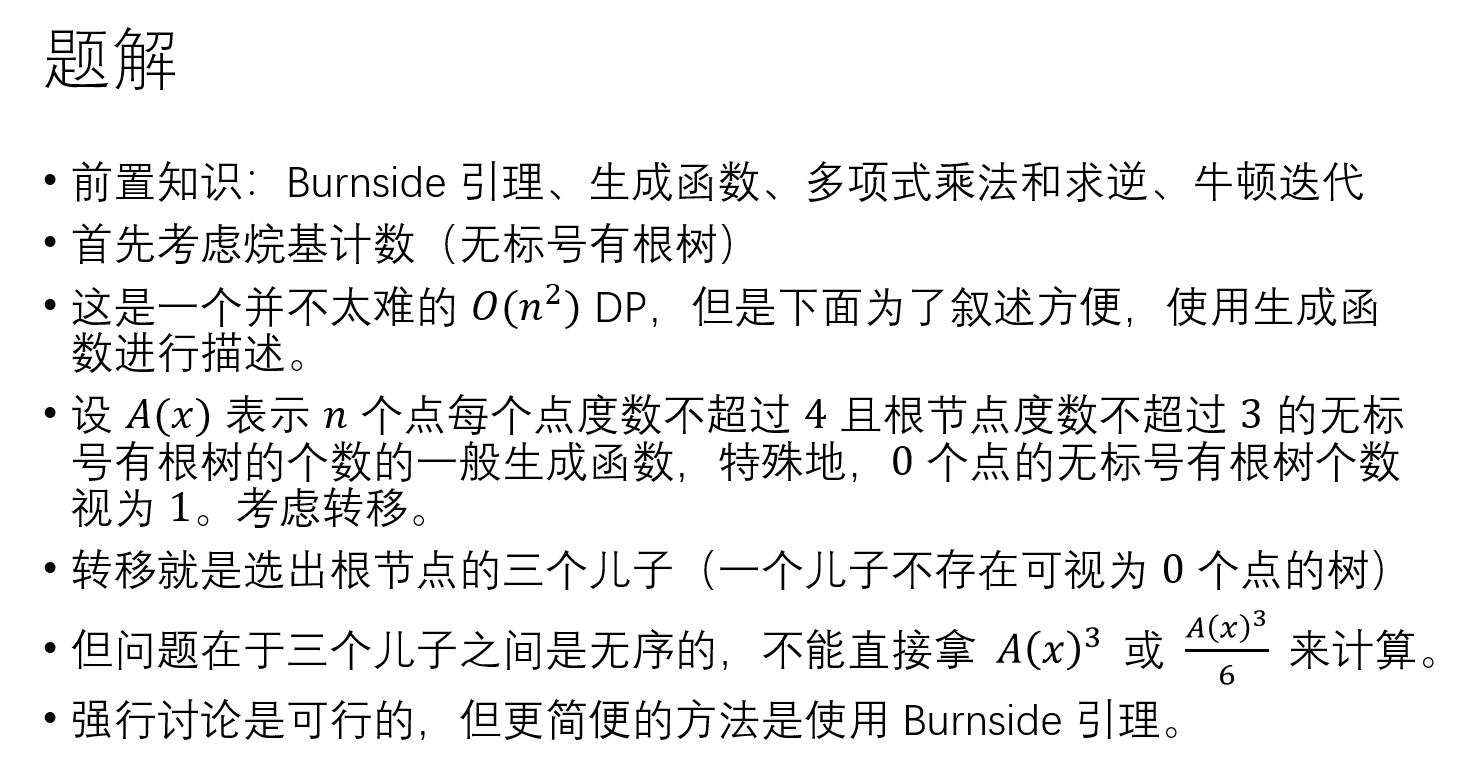
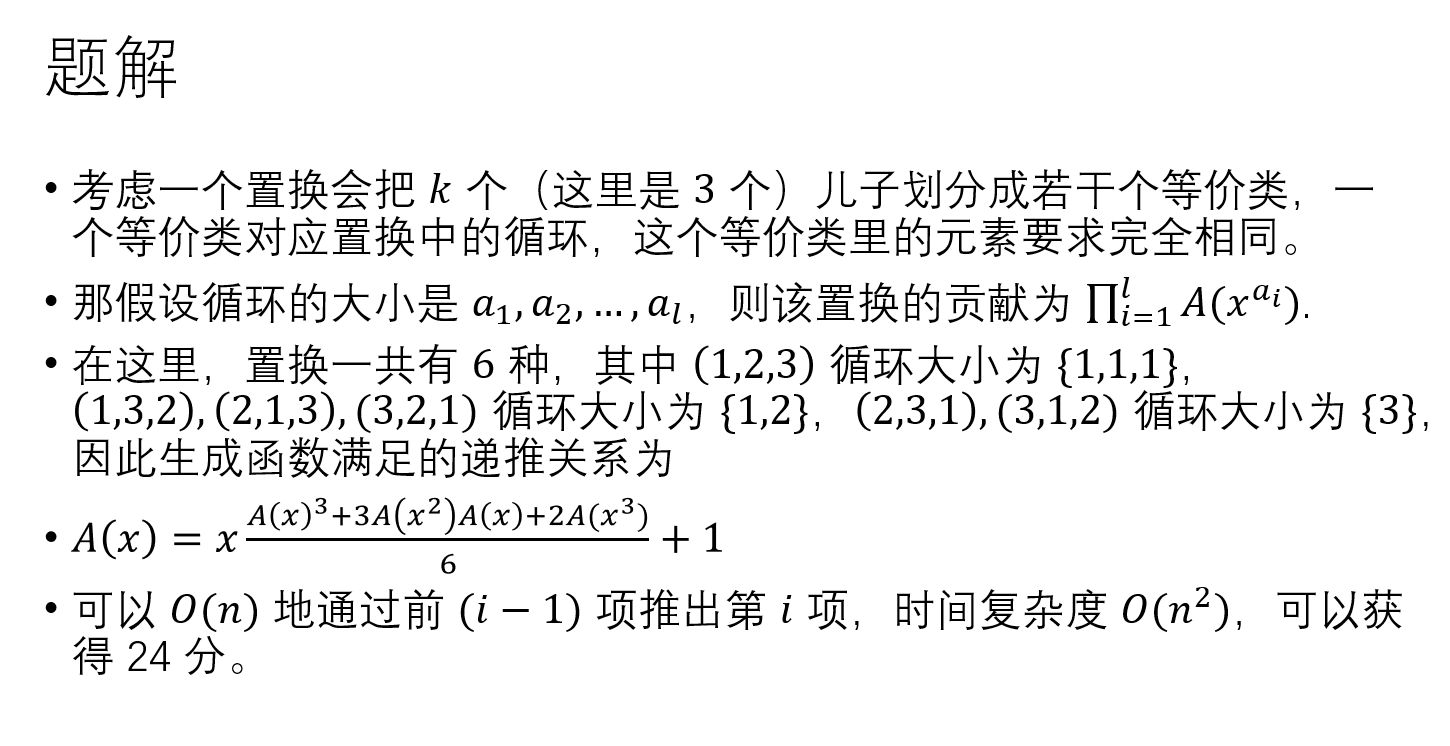
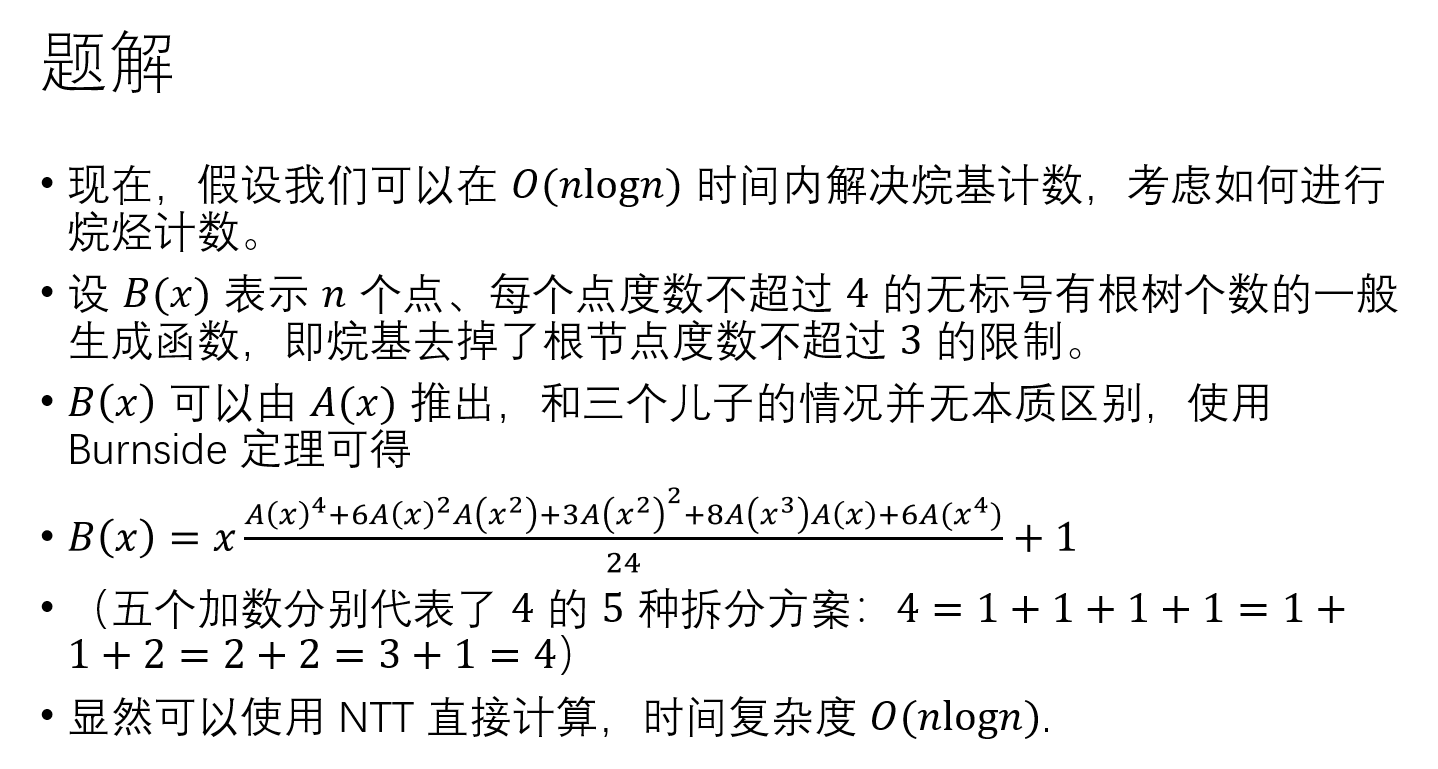
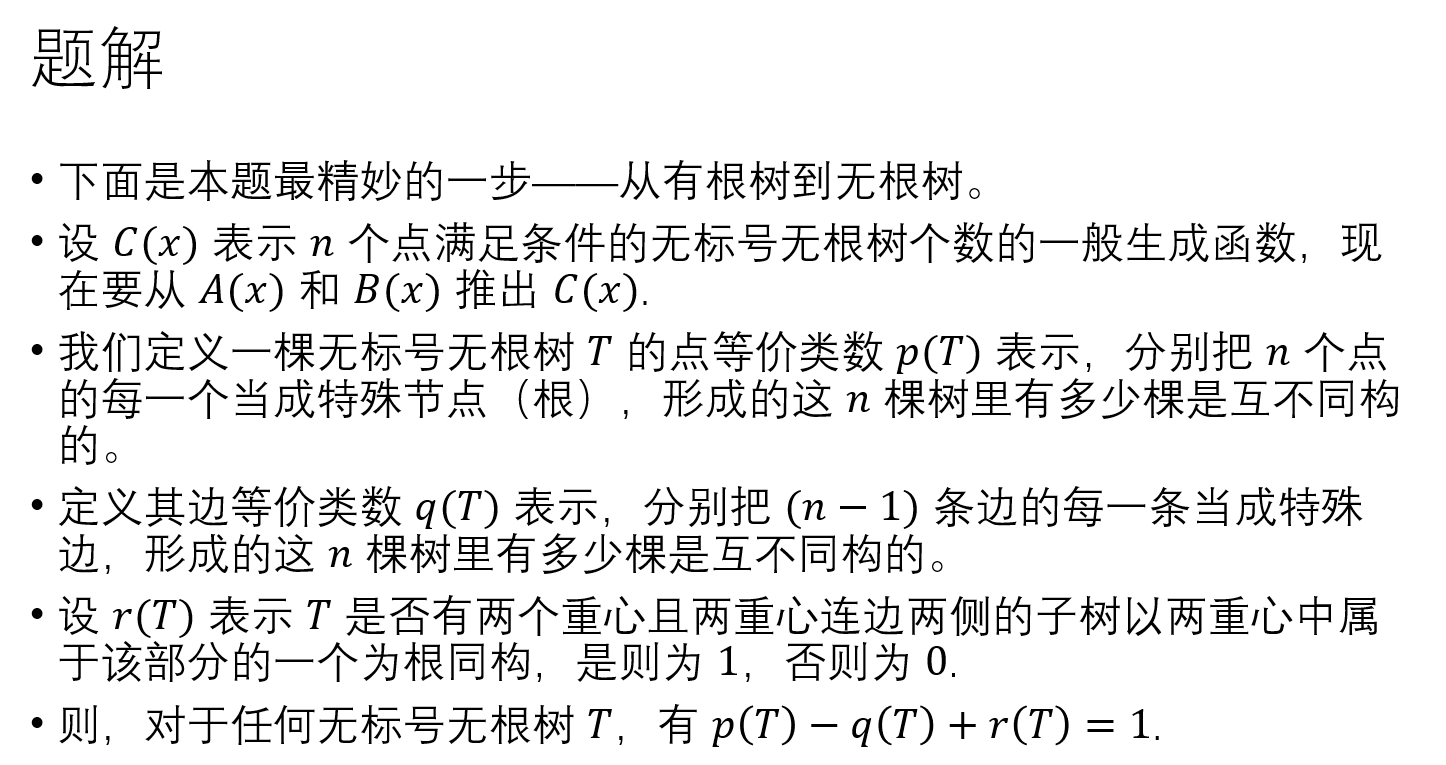
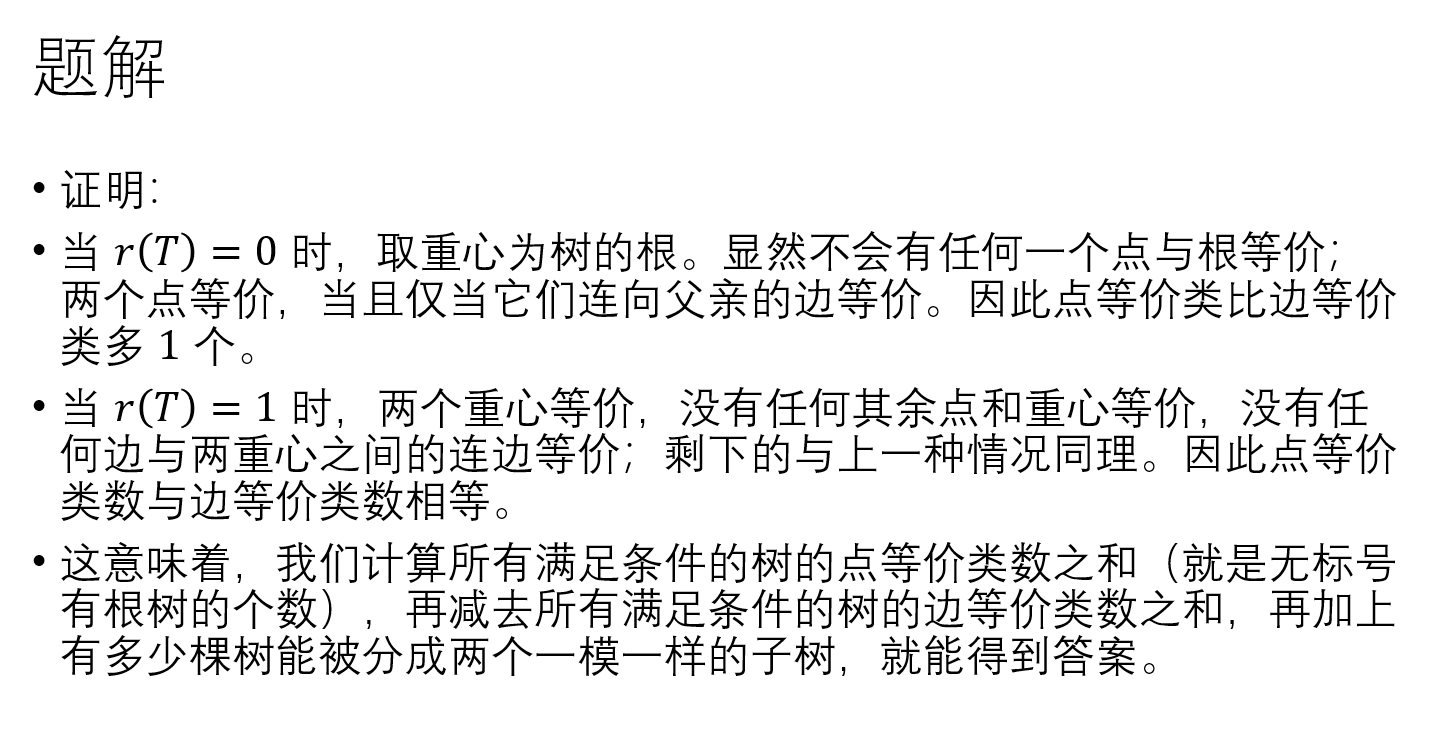
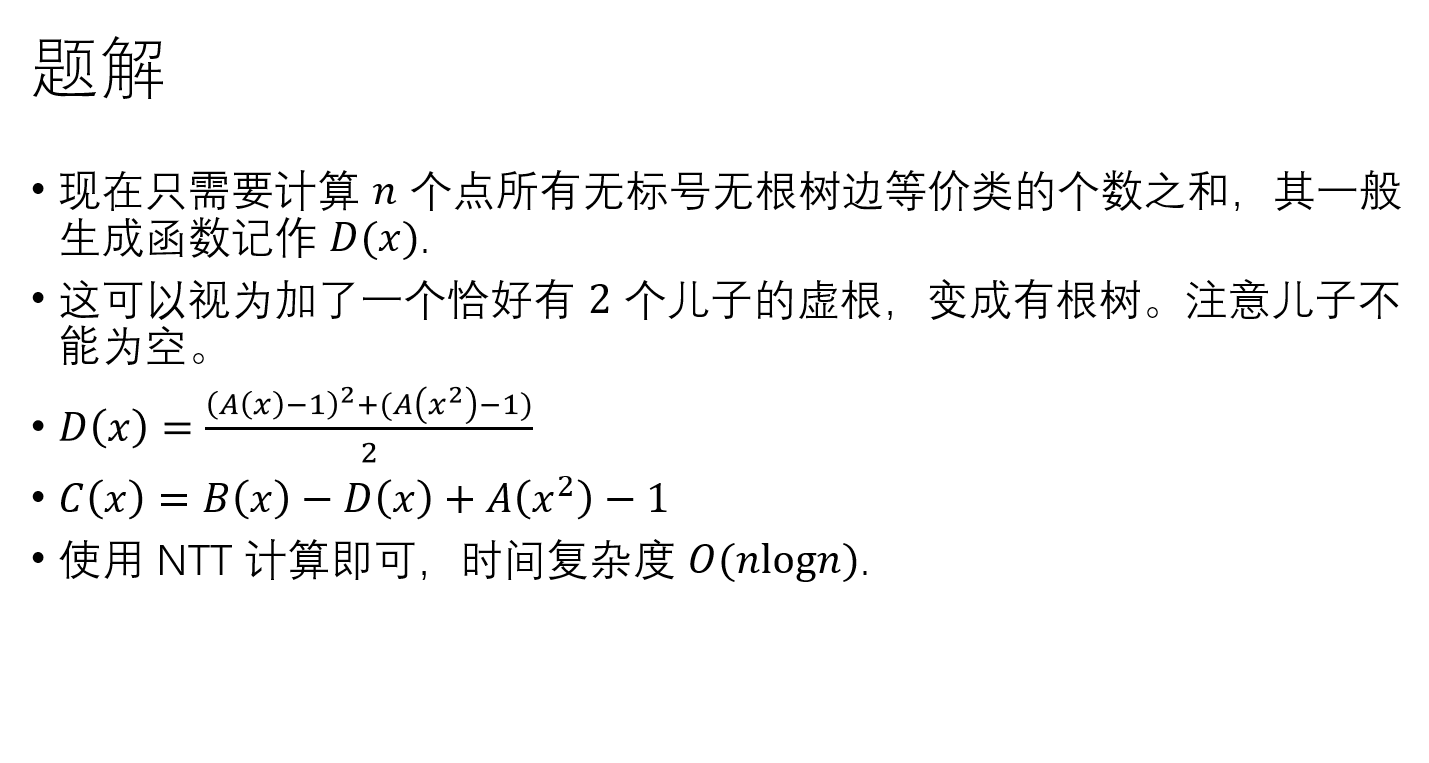
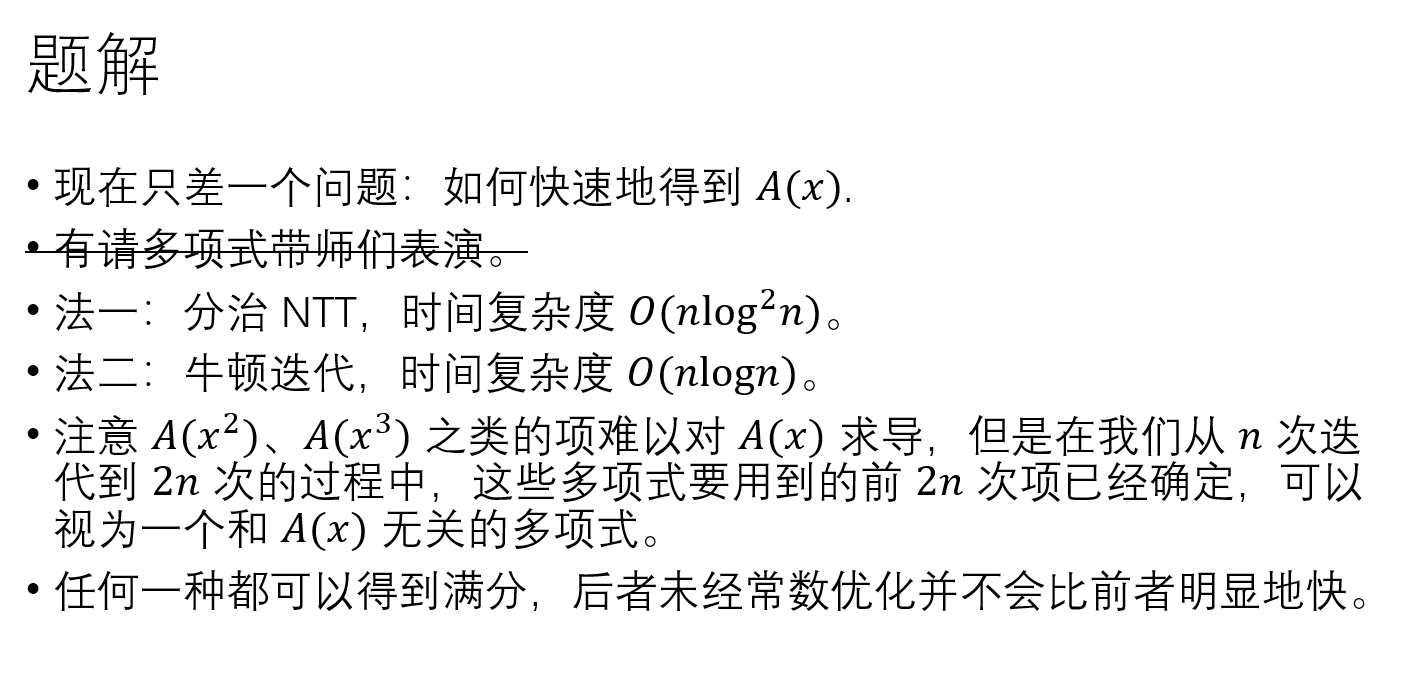
代码
#include<bits/stdc++.h>
#define llong long long
#define mkpr make_pair
#define x first
#define y second
#define iter iterator
#define riter reverse_iterator
#define y1 Lorem_ipsum_
#define tm dolor_sit_amet_
using namespace std;
inline int read()
{
int x = 0,f = 1; char ch = getchar();
for(;!isdigit(ch);ch=getchar()) {if(ch=='-') f = -1;}
for(; isdigit(ch);ch=getchar()) {x = x*10+ch-48;}
return x*f;
}
const int mxN = 1<<19;
const int lgN = 19;
const int P = 998244353;
llong quickpow(llong x,llong y)
{
llong cur = x,ret = 1ll;
for(int i=0; y; i++)
{
if(y&(1ll<<i)) {y-=(1ll<<i); ret = ret*cur%P;}
cur = cur*cur%P;
}
return ret;
}
llong mulinv(llong x) {return quickpow(x,P-2);}
namespace FFT
{
const int G = 3;
llong aux1[mxN+3],aux2[mxN+3],aux3[mxN+3],aux4[mxN+3];
int fftid[mxN+3]; llong sexp[mxN+3];
int getdgr(int n) {int ret = 1; while(ret<=n) ret<<=1; return ret;}
void init_fftid(int dgr)
{
for(int i=1; i<dgr; i++) fftid[i] = (fftid[i>>1]>>1)|((i&1)*(dgr>>1));
}
void ntt(int dgr,int coe,llong poly[],llong ret[])
{
init_fftid(dgr);
if(poly==ret) {for(int i=0; i<dgr; i++) if(i<fftid[i]) swap(ret[i],ret[fftid[i]]);}
else {for(int i=0; i<dgr; i++) ret[i] = poly[fftid[i]];}
for(int i=1; i<dgr; i<<=1)
{
llong tmp = quickpow(G,(P-1)/(i<<1)); if(coe==-1) {tmp = mulinv(tmp);}
sexp[0] = 1ll; for(int j=1; j<i; j++) sexp[j] = sexp[j-1]*tmp%P;
for(int j=0; j<dgr; j+=(i<<1))
{
for(llong *k=ret+j,*kk=sexp; k<ret+i+j; k++,kk++)
{
llong x = *k,y = (*kk)*k[i]%P;
*k = x+y>=P?x+y-P:x+y;
k[i] = x-y<0ll?x-y+P:x-y;
}
}
}
if(coe==-1)
{
llong tmp = mulinv(dgr); for(int i=0; i<dgr; i++) ret[i] = ret[i]*tmp%P;
}
}
void polymul(int dgr,llong poly1[],llong poly2[],llong ret[])
{
memset(poly1+dgr,0,sizeof(llong)*dgr); memset(poly2+dgr,0,sizeof(llong)*dgr);
ntt(dgr<<1,1,poly1,aux1); ntt(dgr<<1,1,poly2,aux2);
for(int i=0; i<(dgr<<1); i++) ret[i] = aux1[i]*aux2[i]%P;
ntt(dgr<<1,-1,ret,ret);
}
void polyinv(int dgr,llong poly[],llong ret[])
{
memset(ret,0,sizeof(llong)*(dgr<<1)); ret[0] = mulinv(poly[0]);
for(int i=1; i<dgr; i<<=1)
{
ntt(i<<2,1,ret,aux3);
for(int j=0; j<(i<<2); j++) aux4[j] = j<(i<<1)?poly[j]:0ll;
ntt(i<<2,1,aux4,aux4);
for(int j=0; j<(i<<2); j++) aux4[j] = (2ll*aux3[j]-aux3[j]*aux3[j]%P*aux4[j]%P+P)%P;
ntt(i<<2,-1,aux4,aux4);
for(int j=0; j<(i<<1); j++) ret[j] = aux4[j];
}
}
}
using FFT::ntt;
using FFT::getdgr;
using FFT::polymul;
using FFT::polyinv;
int dgr; llong Inv2,Inv6,Inv24;
llong aux1[mxN+3],aux2[mxN+3],aux3[mxN+3],aux4[mxN+3],aux5[mxN+3];
llong a[mxN+3],b[mxN+3],c[mxN+3],d[mxN+3];
void calca()
{
a[0] = 1ll;
for(int i=1; i<dgr; i<<=1)
{
int tot = (i<<2)-1;
ntt(i<<2,1,a,aux1);
for(int j=0; j<(i<<2); j++) {aux2[j] = (aux1[j]*aux1[j]%P*aux1[j]%P+3ll*aux1[(2*j)&tot]*aux1[j]%P+2ll*aux1[(3*j)&tot])*Inv6%P;}
ntt(i<<2,-1,aux2,aux2); memset(aux2+(i<<1),0,sizeof(llong)*(i<<1));
for(int j=(i<<1)-2; j>=0; j--) {aux2[j+1] = aux2[j];} aux2[0] = 1ll;
for(int j=0; j<(i<<1); j++) aux2[j] = (aux2[j]-a[j]+P)%P;
for(int j=0; j<(i<<2); j++) {aux3[j] = (aux1[j]*aux1[j]%P+aux1[(2*j)&tot])%P*Inv2%P;}
ntt(i<<2,-1,aux3,aux3); memset(aux3+(i<<1),0,sizeof(llong)*(i<<1));
for(int j=(i<<1)-2; j>=0; j--) {aux3[j+1] = aux3[j];} aux3[0] = P-1ll;
polyinv(i<<1,aux3,aux4);
polymul(i<<1,aux2,aux4,aux5);
for(int j=0; j<(i<<1); j++) {a[j] = (a[j]-aux5[j]+P)%P;}
}
}
int main()
{
int T = read();
dgr = 1<<17; Inv2 = mulinv(2ll),Inv6 = mulinv(6ll),Inv24 = mulinv(24ll);
calca();
int tot = (dgr<<2)-1;
ntt(dgr<<2,1,a,aux1);
for(int i=0; i<(dgr<<2); i++) {b[i] = (aux1[i]*aux1[i]%P*aux1[i]%P*aux1[i]%P+6ll*aux1[i]*aux1[i]%P*aux1[(2*i)&tot]%P+3ll*aux1[(2*i)&tot]*aux1[(2*i)&tot]%P+8ll*aux1[(3*i)&tot]*aux1[i]%P+6ll*aux1[(4*i)&tot])%P*Inv24%P;}
ntt(dgr<<2,-1,b,b); memset(b+dgr,0,sizeof(llong)*dgr*3);
for(int i=dgr-2; i>=0; i--) b[i+1] = b[i]; b[0] = 1ll;
for(int i=0; i<(dgr<<2); i++) {d[i] = (aux1[i]*aux1[i]%P-2ll*aux1[i]%P+aux1[(2*i)&tot]+P)*Inv2%P;}
ntt(dgr<<2,-1,d,d); memset(d+dgr,0,sizeof(llong)*dgr*3);
for(int i=0; i<(dgr<<2); i++) {c[i] = (b[i]-d[i]+(i&1?0ll:a[i/2])+P)%P;} c[0] = (c[0]-1ll+P)%P;
while(T--) {printf("%lld
",c[read()]);}
return 0;
}